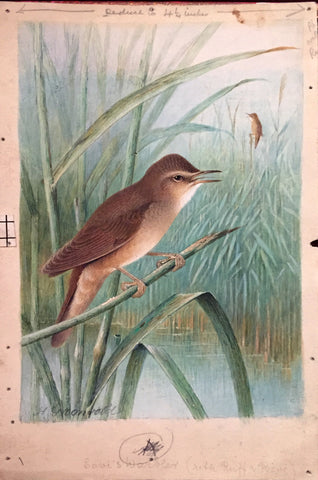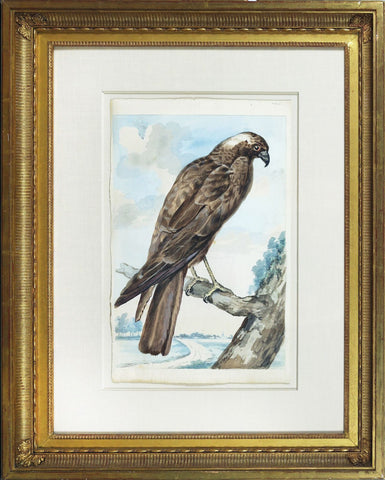
Henrik Grönvold (Danish, 1858 –1940), Locustella Luscinoides (Red Night-Reeler or Savi’s Warbler)
Henrik Grönvold (Danish, 1858 –1940)
“Locustella Luscinoides (Red Night-Reeler or Savi’s Warbler)”
Prepared for Plate X W.H. Hudson and L. Gardiner, Rare, Vanishing and Lost British Birds (1923)
Pencil and watercolor heightened with gouache, some with touches of gum Arabic on paper or card
Signed ‘H Gronvold’ l.l.
1922-1923
Paper size: 8 3/4 x 5 5/8 in.
Provenance: Anonymous sale; Christie’s, London, 17 March 1999, lot 149, private collector.
“The English book-name of this small bird—Savi’s Warbler—was borrowed from the Italian ornithologist who first described it as a distinct species in 1821. It had previously been taken for a variety of the Grasshopper-Warbler, as in form and song it much resembled that curious little songster, or of the Reed-Warbler or of Cetti’s Warbler; but although it was not, as it were, officially recognized until Temminck published his Manual of Ornithology in 1835, it was probably distinguished from its fellow-reeler long before that time by dwellers in the districts it inhabited. In Norfolk and Lincolnshire, where it bred regularly, it was well known to the marshmen as the ‘Red Craking Reed-Wren’ and the ‘Red Night-Reeler’ or ‘Reel-bird,’ from its peculiar song, which resembles the whirring of a reel used by wool-spinners. It was also fairly common in those parts of Cambridgeshire and Huntingdonshire which were suited to its habits. It lives in reed-beds, sings much by night, and makes a cup-shaped nest of closely-interlaced sedge-blades.
It is curious to find this small obscure warbler figuring among the extinct British birds; and when we consider that the largest, most beautiful, or conspicuous species are almost invariably first singled out for destruction by man, one is disinclined to blame him for the disappearance of the Night-Reeler. That its extinction was caused by a system of drainage is scarcely credible. At the best of times it was a rather rare bird, occupying a very limited area; and Mr. Charles Dixon, writing of Lost and Vanishing Birds, compares it in this respect with the Dartford Warbler and other excessively local species which may become extinct rapidly either through the destruction of their favourite haunts or through direct persecution. As to the Dartford Warbler, he adds that the late Henry Swaysland ‘attributed its almost complete disappearance from the gorse coverts of Sussex’ to severe winters. No doubt Swaysland would attribute it to some such cause. Yet the Dartford Warbler has survived not only very severe winters but the destruction of favourite nesting haunts by military camps, better than it survived the destruction carried on in Swaysland’s time for the supply of private collections. About seventy years ago, when collectors became aware at the same time both of the existence and the rarity of the Red Night-Reeler, the usual lively scramble for specimens of the bird and its eggs took place; but it was a bird infinitely more limited in numbers and area than the Dartford Warbler, and not many examples were secured. Its extinction may be said to date back to about the year 1849. One is said to have been ‘obtained’ in Sussex in 1916, and a singular account is given by Dr. Eagle Clarke (Studies in Bird Migration , 1912) of the identification of a pair in the far north of the British Isles. The birds, he says, appeared on Fair Isle, on the 14th May, 1908, and frequented the grassy sides of a burn. ‘They were extremely shy and for several hours baffled all attempts to secure one of them for the purpose of identification.’ At last, however, one, the female, was obtained, and ‘one of the most remarkable events in the history of British ornithology for many years’ was duly recorded. It had perhaps as much connection with British ornithology as the unlucky pair of Bee-eaters which tried to nest the other day at Musselburgh. That is to say, they were accidental visitors.
‘Savi’s Warbler has every claim to be included in a work on British Birds, though it is in all probability extinct in our islands. The marshes where it formerly bred have been to a great extent drained; and nothing has been seen of this interesting bird in its old localities during the last five and twenty years. . . . Many examples of Savi’s Warbler, as well as nests and eggs, were obtained at various dates from 1843 to 1856 in the fens of Norfolk and Cambridge and in one or two other adjoining counties.’— Seebohm’s British Birds.”
HENRIK GRÖNVOLD (DANISH, 1858 –1940)
Henrik Grönvold studied drawing in Copenhagen and worked first as a draughtsman of the Royal Danish Army’s artillery and an illustrator at the Biological Research Station of Copenhagen. In 1892, Grönvold left Denmark for London, employed at the Natural History Museum preparing anatomical specimens. There he became a skilled taxidermist and established a reputation as an artist. He was employed at the Museum until 1895 when he accompanied William Ogilvie-Grant on an expedition to the Salvage Islands. After this expedition, Grönvold worked at the Museum in an unofficial capacity as an artist for decades and only left London to attend an ornithological congress in Berlin.
Grönvold’s illustrations mainly appeared in scientific periodicals such as the Proceedings and Transactions of the Zoological Society, The Ibis, and the Avicultural Magazine. In these publications, he drew plates for William Ogilvie-Grant, George Albert Boulenger, and Michael Rogers Oldfield Thomas, among others. Grönvold also completed numerous plates for Walter Rothschild, many of which appeared in Rothschild’s journal Novitates Zoologicae. Grönvold mostly illustrated birds and eggs, rare and newly discovered species from many parts of the world, and mostly worked in lithographs.
Among the books, Grönvold illustrated is George Shelley’s Birds of Africa, which contained 57 plates, many of which had not been illustrated before. He illustrated W. L. Buller’s books on the birds of New Zealand, Brabourne’s Birds of South America, Henry Eliot Howard’s The British Warblers (1907–14), Charles William Beebe’s A Monograph of the Pheasants (1918–22), and Herbert Christopher Robinson’s The Birds of the Malay Peninsula (1929–76). He completed 600 hand-colored plates for twelve volumes of The Birds of Australia (1910–27) by Gregory Macalister Mathews. Grönvold subsequently provided numerous illustrations for Mathews’ The Birds of Norfolk and Lord Howe Islands … (1928) and A Supplement to The Birds of Norfolk and Lord Howe Islands … (1936).
ORIGINAL WATERCOLORS FOR RARE, VANISHING
AND LOST BRITISH BIRDS
by Henrik Grönvold for William Henry Hudson
William Henry Hudson (1841-1922) was a naturalist, author, and staunch advocate for avian preservation and conservancy. Hudson’s lifelong commitment to protecting the environment stemmed from his youth in Argentina, where he marveled at the beauty of nature, spending endless hours watching the drama of forest and field unfold before him. This idyllic upbringing was beautifully penned in the artist’s work Far Away and Long Ago (1918), which remains a cult favorite amongst many novelists, including Ernest Hemingway, who wrote that Hudson’s book was a must-read for any young writer.
Hudson gravitated to studying birds, which guided his life’s work as an ornithologist and author of numerous tomes on the subject. When he settled in England in 1874, he joined the numerous societies for naturalists of the period and became a founding member of the Royal Society to protect birds.
In 1894, W.H. Hudson produced a leaflet titled Lost British Birds produced for Society for the Protection of Birds. Its purpose was to shed light on thirteen “lost” birds which he defined as those “which no longer breed in this country and visit our shores only as rare stragglers, or, bi-annually, in their migrations to and from their breeding areas on the continent Europe,” to concretely show the effect of industrialism, game hunting, and fashion on the sustainability of certain bird species. This pamphlet was illustrated with 15 rudimentary black and white line drawings by A.D. McCormick. Almost immediately after producing his brochure, Hudson began to collect notes for a future publication that would elaborate upon and update facts on endangered and extinct bird species.
Hudson spent the nineteen-teens and early twenties preparing his next publication. When his notes were organized, and he tapped the celebrated ornithological painter Henrik Grönvold (1858-1940) to produce a sophisticated full-color composition for each bird he intended to discuss at length. However, Hudson suddenly died in 1922 before the publication could come to fruition. Hudson’s colleague, Linda Gardiner, pushed the project forward to see it through in 1923.
Please feel free to contact us with questions by phone at 215.735.8811,
or by email at loricohen@aradergalleries.
We Also Recommend





